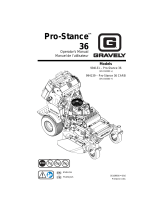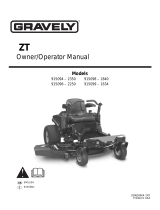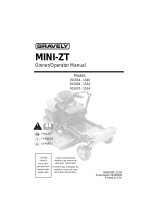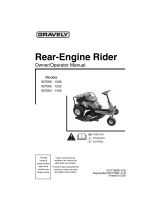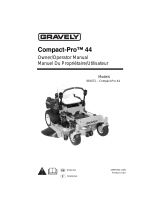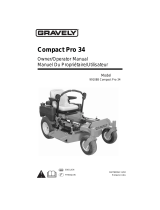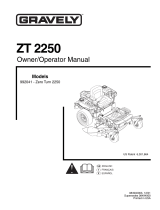Page is loading ...

Operator’s Manual
Manuel de I’utilisateur
ZT HD
05075300C • 6/17
Printed in USA
Models
991152 – ZT HD 48
(SN 000101 +)
991154 – ZT HD 52
(SN 000101 +)
991156 – ZT HD 60
(SN 000101 +)
991160 – ZT HD 44
(SN 000101 +)
991162 – ZT HD 48
(SN 000101 +)
991164 – ZT HD 52
(SN 000101 +)
991166 – ZT HD 60
(SN 000101 +)
991180 – ZT HD 44 CARB
(SN 000101 +)
991182 – ZT HD 48 CARB
(SN 000101 +)
991184 – ZT HD 52 CARB
(SN 000101 +)
991186 – ZT HD 60 CARB
(SN 000101 +)
™
E10
ENGLISH
FRANÇAIS

WELCOME . . . . . . . . . . . . . . . . . . . . . . 1
SAFETY. . . . . . . . . . . . . . . . . . . . . . . . . 2
Practices & Laws . . . . . . . . . . . . . . . . . . 2
Emission Control System. . . . . . . . . . . . 2
Required Operator Training. . . . . . . . . . 2
Safety Alert Symbol . . . . . . . . . . . . . . . . 2
Signal Words . . . . . . . . . . . . . . . . . . . . . 2
Safety Decals. . . . . . . . . . . . . . . . . . . . . 3
Safety Rules. . . . . . . . . . . . . . . . . . . . . . 6
ASSEMBLY. . . . . . . . . . . . . . . . . . . . . . 11
CONTROLS AND FEATURES . . . . . . . 13
Ignition Key . . . . . . . . . . . . . . . . . . . . . . 14
Throttle Control Lever . . . . . . . . . . . . . . 14
Power-Take-Off (PTO) Knob . . . . . . . . . 14
Hour Meter. . . . . . . . . . . . . . . . . . . . . . . 14
Height-of-Cut Adjustment System . . . . . 14
Transport Lock Release Lever. . . . . . . . 15
Deck Lift Pedal. . . . . . . . . . . . . . . . . . . . 15
Seat Adjustment Lever. . . . . . . . . . . . . . 15
Parking Brake Lever . . . . . . . . . . . . . . . 15
Safety Interlock System. . . . . . . . . . . . . 15
Steering Levers . . . . . . . . . . . . . . . . . . . 15
Transaxle Bypass Levers. . . . . . . . . . . . 15
Anti-scalp Rollers. . . . . . . . . . . . . . . . . . 16
OPERATION . . . . . . . . . . . . . . . . . . . . . 16
Emergency Stopping . . . . . . . . . . . . . . . 16
Before Operating Unit . . . . . . . . . . . . . . 16
Start the Engine. . . . . . . . . . . . . . . . . . . 16
Operate Unit. . . . . . . . . . . . . . . . . . . . . . 17
Stop the Engine . . . . . . . . . . . . . . . . . . . 17
Move Unit Manually . . . . . . . . . . . . . . . . 18
Transport Unit . . . . . . . . . . . . . . . . . . . . 18
Release transport lock. . . . . . . . . . . . . . 18
MAINTENANCE . . . . . . . . . . . . . . . . . . 18
Service Position. . . . . . . . . . . . . . . . . . . 18
Maintenance Schedule . . . . . . . . . . . . . 19
Service Parts . . . . . . . . . . . . . . . . . . . . . 19
Hour / Maintenance Meter . . . . . . . . . . . 20
Check Safety Interlock System . . . . . . . 20
Check Parking Brake. . . . . . . . . . . . . . . 20
Check Engine Oil. . . . . . . . . . . . . . . . . . 20
Check Tire Pressure . . . . . . . . . . . . . . . 20
Check Carbon Canister Filter. . . . . . . . . 21
Check Fasteners . . . . . . . . . . . . . . . . . . 21
Lubricate Unit. . . . . . . . . . . . . . . . . . . . . 21
Check Mower Blades. . . . . . . . . . . . . . . 21
Battery Service. . . . . . . . . . . . . . . . . . . . 23
Check Mower Belts . . . . . . . . . . . . . . . . 24
Check Hydraulic System . . . . . . . . . . . . 24
SERVICE & ADJUSTMENTS . . . . . . . . 26
Adjust Seat . . . . . . . . . . . . . . . . . . . . . . 26
Adjust Steering Levers. . . . . . . . . . . . . . 26
Adjust Unit to Drive Straight. . . . . . . . . . 27
Adjust Transaxles . . . . . . . . . . . . . . . . . 27
Electrical Service. . . . . . . . . . . . . . . . . . 28
Replace Transaxle Drive Belt . . . . . . . . 31
Adjust Anti-Scalp Rollers. . . . . . . . . . . . 33
Adjust Parking Brake Lever. . . . . . . . . . 33
Remove and Install Mower Deck. . . . . . 33
Level and Pitch Mower Deck. . . . . . . . . 35
TROUBLESHOOTING . . . . . . . . . . . . . 37
STORAGE. . . . . . . . . . . . . . . . . . . . . . . 39
Short-Term Storage. . . . . . . . . . . . . . . . 39
Long-Term Storage . . . . . . . . . . . . . . . . 39
Start-of-Season Preparation . . . . . . . . . 39
ACCESSORIES. . . . . . . . . . . . . . . . . . . 39
SPECIFICATIONS. . . . . . . . . . . . . . . . . 40
SPECIFICATIONS. . . . . . . . . . . . . . . . . 41
SPECIFICATIONS. . . . . . . . . . . . . . . . . 42
WARRANTY . . . . . . . . . . . . . . . . . . . . . 43
TABLE OF CONTENTS

EN - 1
WELCOME
Congratulations on your purchase and welcome to the Gravely family! Every machine in the
Gravely lineup is designed for long-lasting and unsurpassed performance. We are confident
your machine will be part of your family for many years to come.
Have Questions or Need Assistance?
gravelymower.com • gravely.custhelp.com
A parts manual for your unit is available for free download
or purchase at gravely.com.
Manual del operador español está disponible para su descarga gratuita o
compra en gravely.com.
PRODUCT REGISTRATION
You or the dealer you purchased the unit from
must register the product at the time of
purchase. Know the model and serial
numbers of your unit and register online at
gravely.com or return the registration card to
Ariens Company. See Figure 1 for label
location.
Record model number here.
Record serial number here.
Figure 1
Model & Serial Number Label
MANUALS
Before operating or servicing the unit, carefully
and completely read the manuals provided with
the unit. They contain safety instructions and
important information about unit controls.
The engine on this unit is covered by a
separate manual. Refer to the engine manual
for engine service recommendations. Contact
the engine manufacturer for a replacement
manual if necessary.
Your dealer must review important information
in this manual with you before or upon delivery
of the unit. It is your responsibility to read and
understand all safety precautions and
instructions in the manuals. If you do not
understand or have difficulty following the
instructions, contact your Gravely dealer for
assistance. To locate your nearest Gravely
dealer, go to gravelymower.com.
DISCLAIMER
Gravely reserves the right to discontinue, make
changes to, and add improvements upon its
products at any time without public notice or
obligation. The descriptions and specifications
contained in this manual were in effect at
printing. Equipment described in this manual
may be optional. Some illustrations may not be
applicable to your unit.

EN - 2
Read these safety rules and follow them
closely. Failure to follow these rules could
lead to loss of control of unit, severe personal
injury or death to you or bystanders, or result
in damage to property or the machine.
PRACTICES & LAWS
Practice usual and customary safe working
precautions. Learn applicable rules and laws
in your area. Always follow the practices set
forth in this manual.
EMISSION CONTROL SYSTEM
This equipment and/or its engine may include
exhaust and evaporative emissions control
system components required to meet U.S.
Environmental Protection Agency (EPA)
and/or California Air Resources Board
(CARB) regulations. Tampering with emission
controls and components by unauthorized
personnel may result in severe fines or
penalties. Emission controls and components
can only be adjusted by an Ariens Company
dealer or an authorized engine
manufacturer's service center. Contact your
Ariens Company Equipment Retailer
concerning emission controls and component
questions.
REQUIRED OPERATOR
TRAINING
Read and understand the
Operator's Manual and decals
on the unit. This information is
for your safety and the proper
use of your equipment.
Failure to follow these
instructions and warnings may cause death
or serious injury. If you have purchased this
product from an Gravely dealer, the dealer
can provide you with training.
Familiarize yourself and any other operators
with all controls and the safe use of the
features of this unit. If you loan, rent or sell
this product to others, provide them with all
manuals.
If you have any questions, please call our
customer support line at 920-756-4688 or
contact us at www.gravely.com. Do not use
this equipment if, after reading the Operator's
Manual and the on-board decals, you have
any questions about the safe use of this
product.
SAFETY ALERT SYMBOL
SIGNAL WORDS
The safety alert symbol above and signal
words below are used on decals and in this
manual. Read and understand all safety
messages.
1. Danger
2. Warning
3. Caution
4. Notice
NOTICE: Indicates information or procedures
that are considered important but not hazard
related. If not avoided property damage could
result.
SAFETY
WARNING: AVOID INJURY.
This cutting machine is capable
of amputating hands and feet
and throwing objects. Failure to
observe the safety instructions
in the manuals and on decals
could result in serious injury or
death.
This is the safety alert symbol. It
means:
• ATTENTION!
• YOUR SAFETY IS
INVOLVED!
When you see this symbol:
• BECOME ALERT!
• OBEY THE MESSAGE!
DANGER: Indicates an
IMMINENTLY HAZARDOUS
SITUATION! If not avoided,
WILL RESULT in death or
serious injury.
WARNING: Indicates a
POTENTIALLY HAZARDOUS
SITUATION! If not avoided,
COULD RESULT in death or
serious injury.
CAUTION: Indicates a
POTENTIALLY HAZARDOUS
SITUATION! If not avoided, MAY
RESULT in minor or moderate in-
jury. It may also be used to alert
against unsafe practices.

EN - 3
5. Important
IMPORTANT: Indicates general reference
information worthy of special attention.
SAFETY DECALS
The safety decals on your machine are visual
reminders of the important safety information
in this manual. All messages on your unit
must be fully understood and carefully
followed. Safety decals on the machine are
explained below.
ALWAYS replace missing or damaged safety
decals. Replacement decal part numbers are
found in the parts manual for your machine
and may be ordered from your dealer.
See Figure 2 for safety decal locations.
Safety Decal Locations
07800537
A
KEEP HANDS and FEET AWAY
0
2
9
8
8
1
0
0
P
07800820
07800401
A
Figure 2
1
3
4
5
7
6
2
2
6
8
5
2

EN - 4
Safety Decal Descriptions
1. DANGER!
Discharge Hazard -
NEVER operate unit
without discharge chute in
operating position. Thrown
objects can cause injury or
damage.
DO NOT operate mower
unless all guards are in
operating position or
bagger is attached.
2. DANGER!
Discharge Hazard - NEVER
direct discharge toward
people, pets or property.
Thrown objects can cause
injury or damage.
Amputation Hazard -
NEVER stick hands or feet
under deck or shielded
areas.
Shut off engine, remove key,
and read manual before
servicing or making
adjustments to unit.
Keep children and others
away from unit while unit is
in operation.
Keep feet and hands away
from all rotating or moving
parts.
DO NOT step or stand in
this area.
3. DANGER!
DANGER!
Read and understand the
operator’s manual before
operating unit.
3.1 Amputation Hazard
To avoid amputation hazard
DO NOT put hands near
rotating blades.
To avoid amputation hazard
DO NOT put hands near
moving belts.
Keep hands away from all
rotating or moving parts.
Keep all guards and shields
in place.
3.2 Discharge Hazard
Discharge Hazard - NEVER
direct discharge toward
people, pets or property.
Thrown objects can cause
injury or damage.
DO NOT operate mower
unless all guards are in
operating position or bagger
is attached.
Keep children and people
away from unit during
operation.

EN - 5
3.3 Tipping Hazard
Avoid tipping hazard.
DO NOT operate on slopes
over 15°.
DO NOT operate on slopes
over 15°.
3.4 Service Hazard
Before servicing unit do the
following:
Read owners manual before
servicing or making
adjustments to unit.
Set parking brake.
Remove key and disconnect
spark plug before servicing
or making adjustments to
unit.
3.5 Bystander Hazard
DO NOT operate the unit in
the presence of bystanders.
DO NOT carry passengers.
15
15
P
Look behind when operating
the unit in reverse.
3.6 Loss of Traction Hazard
If loss of traction is
experienced do the
following:
Disengage PTO.
Proceed off slope slowly.
DO NOT try to turn or speed
up.
4. DANGER!
ALWAYS keep hands and
feet away from discharge
chute.
5. HOT PARTS!
DO NOT touch parts which
are hot from operation.
ALWAYS allow parts to cool.
6. ROTATING PARTS!
AVOID INJURY. Stay clear
of rotating parts.

EN - 6
SAFETY RULES
The following safety instructions are based
on the B71.1 specifications of the American
National Standards Institute and ISO 5395 in
effect at the time of production.
7. DANGER!
DANGER!
No smoking.
IMPORTANT: DO NOT
overfill. Fill fuel tank to
below bottom of filler neck.
WARNING: Overfilling may cause severe
damage to evaporative system!
• NEVER fill fuel tank when engine is
running, hot or unit is indoors. NEVER
overfill fuel tank.
• Replace fuel cap securely and clean up
spilled fuel.
8. DANGER!
To avoid amputation hazard
DO NOT put hands near
moving belts.
Keep hands away from all
rotating or moving parts.
Training
Read, understand, and follow all instructions
on the machine and in the manual(s) before
starting.
Be sure the area is clear of bystanders and
pets before operating. Stop machine if
anyone enters the area.
Improper use of power equipment can cause
serious permanent injury or death to the
operator or a bystander.
Understand:
• How to operate all controls
• The functions of all controls
• How to STOP in an emergency
• Braking and steering characteristics
• Turning radius and clearances
If the operator or the mechanic cannot read
the manual, it is the owner’s responsibility to
explain it to them.
ALWAYS train any inexperienced operators
and require them to read and understand all
manuals and decals.
Only allow responsible adults, who are
familiar with the instructions, to operate this
machine.
Only the operator can prevent and is
responsible for accidents or injuries
occurring to themselves, other people or
property.
Operator Age
DO NOT allow children under the age of 18
to operate any outdoor power equipment.
Local regulations may restrict the age of the
operator.
Data indicates operators age 60 years and
above are involved in a large percentage of
riding mower-related injuries.
These operators should evaluate their ability
to operate the riding mower safely enough to
protect themselves and others from serious
injury.

EN - 7
Children
Tragic accidents can occur if the operator is
not alert to the presence of children.
Children are often attracted to the machine
and the mowing activity. NEVER assume
that children will remain where you last saw
them.
Be alert and turn machine off if a child enters
the area.
Before and while backing, look behind and
down for small children.
NEVER carry children, even with the
blade(s) shut off. They may fall off and be
seriously injured or interfere with safe
machine operation. Children who have been
given rides in the past may suddenly appear
in the mowing area for another ride and be
run over or backed over by the machine.
NEVER allow children to operate the
machine.
Use extreme care when approaching blind
corners, shrubs, trees or other objects that
may block your view of a child.
Keep children out of the mowing area and in
the watchful care of a responsible adult
other than the operator.
Personal Protection
DO NOT wear loose clothing or jewelry and
tie back hair that may get caught in rotating
parts.
Wear adequate outer garments.
NEVER wear open sandals or canvas shoes
during operation. Wear adequate safety
gear, protective gloves and footwear.
Wear proper footwear to improve footing on
slippery surfaces.
ALWAYS wear eye and ear protection when
operating machine.
Before Operating
Keep all nuts and bolts tight to be sure the
equipment is in safe working condition.
Maintain the machine to be in compliance
with the maintenance schedule.
Clean grass and debris from unit, especially
from around muffler and engine, to help
prevent fires.
Check parking brake operation frequently.
Adjust and service as required.
Inspect unit before each use for missing or
damaged decals and shields, correctly
operating safety interlock system, and
deterioration of grass catchers. Replace or
repair as needed.
Ensure Safety Interlock System is
functioning properly. DO NOT operate unit if
safety interlock is damaged or disabled.
Start and operate unit only when seated in
operator’s position. Steering control levers
must be in neutral, PTO disengaged and
parking brake set when starting engine.
NEVER interfere with the intended function
of a safety device or reduce the protection
provided by a safety device. Check their
proper operation regularly.
Keep machine free of grass, leaves or other
debris build-up. Clean up oil or fuel spillage
and remove any fuel-soaked debris.
Operation
Be sure the area is clear of bystanders
before operating. Stop machine if anyone
enters the area.
NEVER operate machine in a closed or
poorly-ventilated area.
ALWAYS maintain unit in safe operating
condition. Damaged or worn out muffler can
cause fire or explosion.
This product is equipped with an internal
combustion type engine. DO NOT use unit
on or near any unimproved, forest-covered
or brush-covered land unless exhaust
system is equipped with a spark arrester
meeting applicable local, state or federal
laws. A spark arrester, if it is used, must be
maintained in effective working order by
operator.
DO NOT operate machine while feeling
tired, ill or under the influence of alcohol or
other drugs.
DO NOT put hands or feet near rotating
parts or under the machine. Keep clear of
the discharge opening at all times.
DO NOT touch parts which are hot. Allow
parts to cool.
DO NOT operate machine without the entire
grass catcher, discharge guard or other
safety devices in place and working.
ALWAYS keep hands and feet away from all
pinch points.
Avoid slippery surfaces. ALWAYS be sure of
your footing.
NEVER carry passengers.

EN - 8
NEVER direct discharged material toward
anyone. Avoid discharging material against
a wall or obstruction. Material may ricochet
back toward the operator. Stop the blade(s)
when crossing gravel surfaces.
NEVER engage PTO when attachment,
including mower blades, is not in use.
ALWAYS turn off power to attachment when
not in active use such as traveling or
crossing driveways.
ALWAYS disengage PTO, stop unit and
engine, remove key, engage parking brake
and allow moving parts to stop before
leaving operator’s position.
NEVER engage PTO while raising the
attachment, including mower blades, or
when attachment is in the raised position.
Keep safety devices or guards in place and
functioning properly. NEVER modify or
remove safety devices.
DO NOT mow in reverse unless absolutely
necessary. ALWAYS look down and behind
before and while backing.
Stop engine before removing grass catcher
or unclogging chute.
Slow down before turning.
If you strike a foreign object, stop and
inspect the machine. Repair, if necessary,
before restarting.
NEVER leave a running machine
unattended. ALWAYS turn off blade(s), set
parking brake, stop engine and remove key
before dismounting.
Disengage blade(s) when not mowing. Shut
off engine and wait for all parts to come to a
complete stop before cleaning the machine,
removing the grass catcher, or unclogging
the discharge guard.
Know the weight of loads. Limit loads to
those you can safely control and the unit can
safely handle.
Operating Conditions
Lightning can cause severe injury or death.
If lightning is seen or thunder is heard in the
area, do not operate the machine, seek
shelter.
ALWAYS check overhead and side
clearances carefully before operation.
Watch for traffic when operating near or
crossing roadways.
Clear the area of objects such as rocks,
wire, toys, etc., which could be thrown by the
blades.
Check for weak spots on docks, ramps or
floors. Avoid uneven work areas and rough
terrain. Stay alert for hidden hazards or
traffic.
Use care when approaching blind corners,
shrubs, trees or other objects that may
obscure vision.
Dust, smoke, fog, etc. can reduce vision and
cause an accident.
Operate machine only in daylight or good
artificial light.
Slope Operation
Slopes are a major factor related to loss of
control and tip-over accidents, which can
result in severe injury or death. Operation on
all slopes requires extra caution. If you
cannot back up the slope or if you feel
uneasy on it, DO NOT mow it.
DO NOT operate on slopes of more than
15°.
Mow up and down slopes, not across.
ALWAYS keep the machine in gear when
going down slopes. DO NOT shift to neutral
and coast downhill.
Watch for holes, ruts, bumps, rocks, or other
hidden objects. Uneven terrain could
overturn the machine. Tall grass can hide
obstacles.
DO NOT mow on moist or wet grass. Tires
may lose traction causing a loss of control.
Use extra care while operating machine with
grass catchers or other attachments; they
can affect the stability of the machine. DO
NOT use on steep slopes.
Keep all movements on the slope slow and
gradual. DO NOT make sudden changes in
speed or direction, which could cause the
machine to roll over.
Avoid starting, stopping, or turning on a
slope. If the tires lose traction, disengage
the blade(s) and proceed slowly straight
down the slope.
Operation on slopes may lead to loss of
steering control. When operating on slopes
be prepared to react to an emergency
situation:
• Return steering levers to neutral position.
• Immediately set parking brake.
• Turn off PTO and engine.
DO NOT try to stabilize the machine by
putting your foot on the ground.

EN - 9
DO NOT park on slopes unless necessary.
When parking on slope ALWAYS chock or
block wheels. ALWAYS set parking brake.
Choose a low ground speed so you will not
have to stop or shift while on a slope.
DO NOT mow near drop-offs, ditches, or
embankments. The machine could suddenly
roll over if a wheel goes over the edge or if
the edge caves in.
DO NOT bypass transmission or allow
transmission to free-wheel when on a slope.
Fuel
To avoid personal injury or property damage,
use extreme care in handling gasoline.
Gasoline is extremely flammable and the
vapors are explosive.
Ethanol blends must not exceed E10. Higher
ethanol content may cause your
machine to run hotter and damage your
engine.
Replace fuel cap securely and clean up
spilled fuel before starting engine.
Extinguish all cigarettes, cigars, pipes and
other sources of ignition.
Use only an approved gasoline container.
NEVER store the machine or fuel container
where there is an open flame, spark or pilot
light such as on a water or space heater or
other appliances.
NEVER fill containers inside a vehicle or on
a truck or trailer bed with a plastic liner.
ALWAYS place containers on the ground
away from your vehicle before filling.
NEVER fuel the machine indoors.
NEVER remove gas cap or add fuel with the
engine running. Allow engine to cool before
fueling.
Fuel is highly flammable and its vapors are
explosive. Handle with care. Use only an
approved gasoline container with an
appropriately-sized dispensing spout.
NO smoking, NO sparks, NO flames.
Remove gas-powered equipment from the
trailer and refuel it on the ground. If this is
not possible, then refuel such equipment
with a portable container, rather than from a
gasoline dispenser nozzle.
Keep the nozzle in contact with the rim of
the fuel tank or container opening at all
times until the fueling is complete. DO NOT
use a nozzle lock-open device.
NEVER overfill fuel tank. Replace gas cap
and tighten securely.
If fuel is spilled on clothing, change clothing
immediately.
Towing
Follow the manufacturer’s recommendations
for weight limits for towed equipment and
towing on slopes.
NEVER allow children or others in or on
towed equipment.
Tow only with a machine that has a hitch
designed for towing. DO NOT attach towed
equipment except at the hitch point.
On slopes, the weight of the towed
equipment may cause loss of traction and
loss of control.
Travel slowly and allow extra distance to
stop.
Accessories
Follow the manufacturer’s recommendation
for wheel weights or counterweights
Check grass catcher components and the
discharge guard frequently and replace with
the manufacturer’s recommended parts,
when necessary.
Use only Ariens Company-recommended
attachments that are appropriate to your use
and can be used safely in your application.
Batteries
Avoid electric shock. Objects contacting
both battery terminals at the same time may
result in injury and unit damage. DO NOT
reverse battery connections.
Reverse connections may result in sparks
which can cause serious injury. ALWAYS
connect positive (+) lead of charger to
positive (+) terminal, and negative (-) lead to
negative (-) terminal.
ALWAYS disconnect negative (-) cable
FIRST and positive (+) cable SECOND.
ALWAYS connect positive (+) cable FIRST,
and negative (-) cable SECOND.
Explosive gases from battery can cause
death or serious injury. Poisonous battery
fluid contains sulfuric acid and its contact
with skin, eyes or clothing can cause severe
chemical burns.

EN - 10
No flames, No sparks, No smoking near
battery.
ALWAYS wear safety glasses and protective
gear near battery. Use insulated tools.
ALWAYS keep batteries out of reach of
children.
Battery posts, terminals and related
accessories contain lead and lead
compounds, chemicals known to the state of
California to cause cancer and reproductive
harm. Wash hands after handling.
Service
The use of non-genuine replacement parts
or accessories could adversely affect
machine operation and safety.
Do not change engine governor setting or
overspeed the engine.
Maintain or replace safety and instruction
labels as necessary.
Keep unit free of debris. Clean up oil or fuel
spills.
ALWAYS block wheels and know all jack
stands are strong and secure and will hold
weight of unit during maintenance.
Release any pneumatic or hydraulic
pressure from components slowly.
NEVER attempt to make any adjustments to
unit while engine is running (except where
specifically recommended). Stop engine,
remove key and spark plug wire and wait for
all moving parts to stop before servicing or
cleaning.
Lower cutting deck unless a positive
mechanical lock is used.
Allow engine to cool before servicing.
Moving parts can cut or amputate fingers or
a hand. On multiblade mowers, rotation of
one blade will cause all blades to rotate.
NEVER weld or straighten mower blades.
NEVER make adjustments or repairs with
the engine running.
Mower blades are sharp. Wrap the blade or
wear gloves, and use extra caution when
servicing them.
ALWAYS keep body and hands away from
pin holes or nozzles which eject hydraulic
fluid under pressure.
Transporting Unit
Use extra care when loading or unloading
the machine into a trailer or truck.
Secure unit chassis to transport vehicle.
NEVER secure from rods or linkages that
could be damaged.
DO NOT transport machine while engine is
running.
ALWAYS turn off power to attachment and
shut off fuel when transporting unit.
Storage
NEVER store unit with fuel in fuel tank inside
a building where any ignition sources are
present.
Keep machine free of grass, leaves or other
debris build-up. Clean up oil or fuel spillage
and remove any fuel-soaked debris. Allow
machine to cool before storing.
For extended storage, close fuel shut off
valve and clean unit thoroughly. See engine
manual for proper storage.

EN - 11
1. Remove wrap and packaging materials
from unit.
2. Remove unit from shipping container.
See Move Unit Manually on page 18.
3. Return seat to operating position. See
Figure 3.
4. Place the discharge chute in the
operating position. See Figure 4.
5. Remove two eccentric spacers, two
round head square neck bolts and two
locking nuts from hardware bag.
6. Rotate steering levers to operating
position and install eccentric spacer
between steering lever plates. Secure
with hardware. See Figure 5.
4. Adjust steering levers. See Adjust
Steering Levers on page 26.
5. Check tire pressures and inflate to
recommendation. See Specifications on
page 40.
ASSEMBLY
WARNING: AVOID INJURY.
Read and understand the
Safety section before
proceeding.
Figure 3
Figure 4
WARNING: AVOID INJURY.
Explosive separation of tire
and rim parts is possible.
• DO NOT inflate tires above
maximum pressure listed
on tire sidewalls.
• DO NOT inflate tires with a
compressor; use a hand
pump.
• DO NOT stand in front of
tire assembly when
inflating. Use a clip-on
chuck and extension hose
long enough to allow you to
stand to one side.
WARNING: DO NOT mount a
tire without proper equipment
and experience.
1. Eccentric Spacer
2. Steering Lever
3. Steering Lever Plate
1
2
3
Figure 5

EN - 13
1. Fuel Tank and Cap
2. Fuel Level Window
3. Oil Filter
4. Oil Drain
5. Engine Oil Dipstick
6. Air Filter
7. Ignition Key
8. Choke Control Knob (Models 991160,
162, 164, 166, 180, 182, 184, 186)
9. Throttle Control Lever
10. Power Take-off (PTO) Knob
11. Hour Meter
12. Height-of-Cut Adjustment System
13. Transport Lock Release Lever
14. Deck Lift Pedal
15. Seat Adjustment Lever
16. Parking Brake Lever
17. Belt Cover (2)
18. Steering Lever (2)
19. Discharge Chute
20. Anti-Scalp Roller (6)
21. Transaxle Bypass Lever (2)
22. Battery (Under Seat)
23. Fuse Box
24. Hydraulic Oil Expansion Tank (2)
25. Carbon Canister (Models 991180, 182,
184, 186)
CONTROLS AND FEATURES
Figure 6
6
20
23
4
22
5
20
24
3
9
12
10
7
11
13
16
19
14
2
1
15
8
18
17
5
3
4
6
21
25
Models
991152
991154
991156
Models
991160 991180
991162 991182
991164 991184
991166 991186

EN - 14
See Figure 6 for all controls and features
locations.
IGNITION KEY
See Figure 7.
Controls power to the engine. The key cannot
be removed when in run position.
CHOKE CONTROL KNOB
Models 991160, 162, 164, 166, 180, 182,
184, 186
See Figure 8.
Controls airflow to the engine.
THROTTLE CONTROL LEVER
See Figure 9.
Controls engine speed.
POWER-TAKE-OFF (PTO) KNOB
See Figure 10.
Controls power to mower blades. The engine
will not start with the PTO knob in the on
position.
HOUR METER
Displays the amount of time spent on
individual jobs, service alerts, and
recommended service intervals.
HEIGHT-OF-CUT ADJUSTMENT
SYSTEM
Sets the height of cut.
WARNING: AVOID INJURY.
Read and understand the
Safety section before
proceeding.
Figure 7
Off
Start
On
Figure 8
Choke On
Choke Off
WARNING: AVOID INJURY.
Blades will not immediately
stop after pushing PTO knob
down to off position.
C
Figure 9
Fast
Slow
Figure 10
Blades Off
Blades On

EN - 15
TRANSPORT LOCK RELEASE
LEVER
See Figure 11.
Releases deck from transport lock position.
DECK LIFT PEDAL
Raises mower deck to change height-of-cut
setting.
SEAT ADJUSTMENT LEVER
Unlocks seat to allow operator to move seat
forward or backward and then lock in desired
position.
PARKING BRAKE LEVER
See Figure 12.
Controls the parking brake. The engine will
not start with brake in the off position.
SAFETY INTERLOCK SYSTEM
Monitors the interaction of various unit
features for operator safety.
STEERING LEVERS
Control the direction and speed of unit. The
levers gradually return to neutral when
released and are locked in neutral when
parking brake is set.
TRANSAXLE BYPASS LEVERS
Engage and disengage the transaxles so unit
may be moved with the engine off.
Figure 11
Figure 12
Brake Released (Off)
Brake Engaged (On)

EN - 16
ANTI-SCALP ROLLERS
Help prevent the deck from contacting the
ground and scalping the lawn when passing
over a high spot.
IMPORTANT: All references to left, right, front
or rear are given from the perspective of
operator in operator’s position, facing the
direction of forward travel.
EMERGENCY STOPPING
1. Move steering levers to neutral position.
2. Set parking brake.
3. Push PTO knob down to off position.
4. Turn ignition key to off position and
remove key.
BEFORE OPERATING UNIT
1. Check fuel level and add fuel if needed.
IMPORTANT: Use fresh unleaded fuel with
an octane rating of at least 87. DO NOT use
E85 blended fuels; the engine is not E20 /
E30 / E85 compatible. The maximum
recommended ethanol content is 10%.
Gravely recommends using a quality fuel
stabilizer in all fuel. See Short-Term Storage
on page 39.
2. Check engine oil level and add oil if
needed. Refer to engine manual.
3. Check condition of air cleaner. Refer to
engine manual.
4. Check function of the Safety Interlock
System by performing the tests in Check
Safety Interlock System on page 20.
Contact your Gravely dealer for repair if
any of the tests fail.
5. Set cutting height. See Figure 13.
a. Push mower lift pedal forward until
transport lock engages.
b. Insert adjustment pin through desired
setting in height-of-cut adjustment
system.
c. Push mower lift pedal slightly forward,
release transport lock and slowly
release pedal until it contacts
adjustment pin and stops.
START THE ENGINE
1. Push PTO knob down to off position.
2. Move steering levers to neutral position.
3. Engage parking brake.
4. Models 991160, 162, 164, 166, 180, 182,
184, 186 Only: If engine is cold, pull
choke knob up to on position. If engine is
warm or hot, turn choke off.
5. Set throttle to slow speed.
6. Insert ignition key and turn to start
position. Release key when engine starts.
NOTICE: Do not operate the starter for more
than 10 seconds at a time. If the engine does
not start, allow a 60-second cool down period
between starting attempts.
7. Models 991160, 162, 164, 166, 180, 182,
184, 186 Only: If choke is on, wait a few
seconds after engine starts and then push
choke knob down to off position.
IMPORTANT: Make sure choke is completely
off. Engine will not run smoothly using partial
choke.
OPERATION
WARNING: AVOID INJURY.
Read and understand the
Safety section before
proceeding.
Figure 13
1. Deck Lift Pedal
2. Height-of-Cut Adjustment System
1
2

EN - 17
OPERATE UNIT
1. Release parking brake.
2. Set throttle to slow speed.
3. Pull PTO knob up to on position.
IMPORTANT: Never engage the PTO if the
mower is plugged with grass or other
material. This may cause damage to the
electric clutch.
4. Move throttle control lever to fast.
5. Move steering levers to begin mowing.
IMPORTANT: Aggressive turning can scuff or
damage lawns. Always keep both wheels
rotating when making sharp turns. DO NOT
make turns with inside wheel completely
stopped. For minimum turning radius, slowly
reverse inside wheel while moving outside
wheel slowly forward.
For Best Mowing Results
• Cut grass when it is dry.
• Keep mower blades sharp.
• Keep mower deck properly leveled.
• Adjust anti-scalp rollers to prevent scalping.
• Do not set height of cut too low. For very
tall grass, mow twice.
• Do not travel too fast.
• Mow with the engine set at full throttle.
• When mulching, only remove 1/3 of grass
length per cutting. Do not cut more than
2.5 cm (1") at any one time.
• Discharge clippings into areas already cut.
• Vary cutting pattern with each mowing.
• Do not allow grass or debris to collect
inside of mower deck. Clean after each
use.
STOP THE ENGINE
1. Place steering levers in neutral position
and rotate outward.
2. Engage parking brake.
3. Push PTO knob down to off position.
4. Set throttle to slow speed.
5. Turn ignition key to off position and
remove key.
WARNING: AVOID INJURY.
Move the steering levers
slowly and keep the throttle at
slow speed until you learn how
to operate the unit.
Direction
of Travel
Lever Position
Forward Push both levers
forward from
neutral position.
Reverse Pull both levers
backward from
neutral position.
Right Turn Push left lever
farther forward
than the right
lever.
Left Turn Push right lever
farther forward
than the left lever.
Stop Return both
levers to neutral
position.
WARNING: AVOID INJURY.
Wait for all moving parts to
stop before leaving operator’s
position.

EN - 18
MOVE UNIT MANUALLY
Bypass the transaxles to move the unit with
the engine off.
See Figure 14.
IMPORTANT: There is one transaxle bypass
lever on each side of unit. Ensure that both
levers are fully in front or rear position.
1. Stop engine, remove key and wait for
moving parts to stop and for hot parts to
cool. See Stop the Engine on page 17.
2. Pull both transaxle bypass levers out into
bypass position.
3. Release parking brake and push unit to
desired location.
4. Engage parking brake.
5. Return transaxle bypass levers to
operating position. See Figure 15.
TRANSPORT UNIT
1. Push deck lift pedal completely forward to
engage transport lock. Release pedal.
2. Move unit to transport vehicle.
3. Stop engine, engage parking brake,
remove key from ignition.
4. Secure mower frame to transport vehicle.
NOTICE: NEVER secure unit to vehicle from
rods or linkages that could be damaged.
RELEASE TRANSPORT LOCK
1. Push deck lift pedal forward and lift
transport lock release lever.
2. Slowly return mower lift pedal to resting
position.
Proper maintenance can prolong the life of
unit. The Maintenance Schedule on page 19
shows the recommended service schedule.
Your Gravely dealer can provide service and
adjustments to keep your unit operating at
peak efficiency. Contact an authorized engine
manufacturer’s service center for engine
service.
More frequent service may be required due to
working conditions (heavy loads, high
ambient temperatures, dusty conditions, or
airborne debris).
See the maintenance instructions in the
Engine Manual for additional information.
SERVICE POSITION
See Figure 16.
1. Park unit on a flat, level surface.
2. Stop engine, remove key and wait for
moving parts to stop and for hot parts to
cool.
3. Chock wheels. Strap and clamp unit onto
lift, if used.
4. Place steering levers in neutral position
and rotate outward.
5. Engage parking brake.
6. Rotate seat forward.
Figure 14
Figure 15
MAINTENANCE
WARNING: AVOID INJURY.
Read and understand the
Safety section before
proceeding.
/

